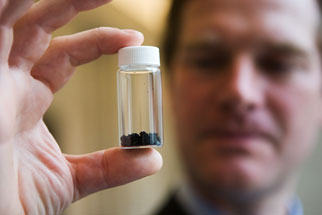The Dangers of Nanotech
- By David Levin
- Posted 01.13.11
- NOVA
In the growing field of nanotechnology, engineers are creating countless new microscopic materials. They're used in thousands of consumer goods, from cell phones to cosmetics and sunscreen. But how safe are they? Andrew Maynard is a physicist and director of the Risk Science Center at the University of Michigan. We talked to him about the potential dangers of nanotech.
 Listen
Listen
Nanomaterials are used in consumer goods from cell phones to sunscreen. But how safe are they?
Transcript
The Dangers of Nanotech
Posted January 13, 2011
DAVID LEVIN: You're listening to a NOVA podcast. I'm David Levin.
Today, we're talking about nanotechnology—engineering materials on a microscopic level. Over the last few years, nanotech has been used in all kinds of things, from cell phones to cosmetics and sunscreen. It's everywhere. But how safe are it? To find out, I talked Andrew Maynard. He's a physicist and director of the Risk Science Center at the University of Michigan.
DAVID LEVIN: So when we say nanotechnology, how small are we talking? Maybe you can help us put that in perspective.
Yeah, this is a question that you always get when you you're talking about nanotechnology, just how small is it? And the answer is, it's really hard to visualize. At the bottom end, we're talking about atoms and molecules. So if you think about how small the smallest atom is, that's as small as we go. And that's 'round about 1 nanometer, one billionth of a meter. If you take a hair out of your head, that's about a hundred thousand meters in diameter. So nanotechnology is all about doing stuff at a scale between a hundred thousand times and a thousand times thinner than one of your hairs.
DAVID LEVIN: How can a material that's just simply small have an impact on someone's health? I mean, what are some of the health issues that this could raise?
ANDREW MAYNARD: At the moment, the health issues are very speculative. So the argument goes something like this. You take a substance and you make it very, very, small, and suddenly it begins to show new behaviors. It might show a very different chemical or biological behavior, so immediately you have to ask, "does that lead to new risks?" Or it might simply be that if it's very small it can get to new places. For instance, we know that if you take rats and you allow them to inhale very, very, small airborne particles, some of those particles can actually travel up the nasal nerves and get into the brain. That's not somewhere you would expect to see small particles. So these are two questions that people ask. Can it get to places that it shouldn't, and can it cause an effect simply because the chemistry is very different at that very small scale. But as yet, we have remarkably little information on actual health effects. We just have this hint of doubt that there might be something new happening.
DAVID LEVIN: You know, it seems like we've been down a similar road before, in the 1950s and 60s with industrial chemistry. We were pretty naí¯ve then about the health impacts of industrial chemicals. Do you think we're approaching nanotech more cautiously?
ANDREW MAYNARD: I think we are. So, we've learned a lot from previous technologies—synthetic chemistry and the chemicals revolution in particular, where we've realized that we have to be a little smarter about the safety of the things that we produce. And because of that, over the last 10 years, you've seen an enormous effort placed on trying to understand the possible health impacts of engineered nanomaterials before they become used very widely. Whether we've actually been able to provide the information we need to develop these technologies safely is another question. We've really struggled there. But certainly, the intent has been there to do things differently.
DAVID LEVIN: But do we really have the means to effectively test the safety of nanomaterials since they're so new?
ANDREW MAYNARD: Well, we're really struggling. So yeah, that's the first question. You come up with something new, and you say, well, how can we test it to see how safe or how toxic it is, or how much somebody's been exposed to it? We suddenly realize we don't have the tools available. In some cases we do. In some cases you can use fairly standard ways of showing how much stuff somebody's been exposed to or how toxic it is. But in other cases, we're actually really struggling. So step one has been to actually work out how we measure what we need to measure.
DAVID LEVIN: And what are the cases that we're struggling with in particular?
ANDREW MAYNARD: Well, let me use one particular material, for example, which is carbon nanotubes. And these are a very unique material, which—they're made out of carbon atoms, obviously very common, found in things like diamond and graphite. But they're wrapped 'round into long, thin, cylinders to create a very strong, light, unusual material. And because of its nature, there's been a lot of concern that if you inhale this, it might cause problems. But actually working out how you measure that material is really tough, because it's just carbon. So if you were to just to measure carbon, you wouldn't be able to tell whether somebody had just inhaled a lungful of smoke or a lungful of carbon nanotubes. And then, what's important here is the actual physical shape of the carbon nanotubes, whether they're long and thin, or whether they're short and tangly. And it's really, really difficult. if you take a sample of air, to actually differentiate which of the carbon nanotubes, or which of the nanotubes have got a shape that which we need to be worried about as opposed to those which maybe we shouldn't worry about so much. Simply because they're so small and they're so complex.
DAVID LEVIN: So what is it about the nanotube shape in particular that could be problematic?
ANDREW MAYNARD: The thing that really worries people is the carbon nanotubes that look a little bit like asbestos fibers. So we know from the whole sordid history of asbestos that if you're going to inhale fibers into your lungs that are very long, and very thin, and straight, and stick around for a long time so they don't biodegrade easily, they can work their way to the edge of the lung where they lead to repeated inflammation, and eventually they potentially lead to devastating diseases such as mesotheliomoa. And we know that's because of the physical structure as well as the chemistry of these. So then the question is, if you come up with another that looks like asbestos, like long, thin, straight, non-biodegradable carbon nanotubes, are they gonna show the same behavior? And the indications are that, yeah, they possibly do. And it's down to their shape as much as their chemistry.
DAVID LEVIN: You know, I'm glad you brought up that distinction, because carbon, for one, comes in lots of different forms, but it's still carbon. Could be tiny spheres, nanotubes, or even graphine, just a single sheet of carbon atoms. So are we even close to sorting out the effects of shape vs. chemistry when we're trying to understand the risks?
ANDREW MAYNARD: This is one of the biggest challenges we face. And we're getting somewhere, but we're not moving too fast on it. So yeah, we've had to—we've been trained over the last 50-100 years to think in terms of chemistry. So we've thought in the past that if we can understand the chemicals that something's made up of, we understand how harmful it is. But now we know we've got to think about forms. So we've got to think about whether those carbon atoms are in a carbon-60 molecule, or whether they're in carbon nanotubes, or a sheet of graphene, or whatever. Shape matters. And this is such a novel dimension to our thinking when it comes to understanding safety that we really don't have the mental models to understand how to deal with it yet. We're still stuck in this chemistry paradigm. But we're beginning to learn to ask the right questions. So you take carbon-type materials, for instance, graphene sheets, you can think intuitively, it's hard to imagine how they can be a significant health hazard. I may be wrong here, but it's hard to imagine how a sheet of graphene can get into the body and stay as a sheet of graphene in a way that is gonna cause a novel risk. On the other hand, carbon nanotubes, it's very clear that this is a type of material that can get into the body and still can retain that unique shape and cause harm because of that shape.
DAVID LEVIN: So who is currently doing research on this, and who do you think should be doing the bulk of the research?
ANDREW MAYNARD: There's research being carried out both in industry and sponsored by the government, and in fact, in government labs. And we've seen a huge explosion in research into looking into the potential safety aspects of nanomaterials over the last two or three years. The big question is whether it's enough research and whether it's going in the right direction, but it's gratifying to see that so much work is being done. To be honest, though, we still really are struggling to work out what the questions are we're supposed to be answering here. So we've got this sense that there's an important question that we need to answer if we're going to develop these new materials safely. We're just not sure what those questions are.
But I actually think that the challenges we face go way beyond these materials. These are just one small subset of new materials, innovative materials that are coming along. And I think it's very clear that whatever we produce in the future through innovation, we've got to be far smarter, and far more innovative, if you like, in how we develop these so we make sure that these new materials actually lead to good solutions to problems that are going to be safe and are going to be sustainable, and this requires a different way of thinking about risk and innovation and uncertainty.
DAVID LEVIN: Well, Dr. Maynard, thanks again for speaking with me. It's been a real pleasure.
ANDREW MAYNARD: Thanks very much.
DAVID LEVIN: Andrew Maynard is Director of the Risk Science Center at the University of Michigan. He also blogs about science and technology at 2020science.org.
Credits
Audio
- Produced by
- David Levin
Image
- (carbon nanotubes)
- © Project on Emerging Nanotechnologies
Related Links
-

Making Stuff: Smaller
Future technologies will depend on tiny stuff—from silicon chips to micro-robots that probe the human body.
-

The Art of Nanotech
See a selection of award-winning images of nanoscale materials.
-

Working With Nanoshells
In this interview, nanotechnologist Naomi Halas talks in depth about her work with tiny spheres that hold great promise.
-

Cancer Nanotech
Structures smaller than a single red blood cell could revolutionize cancer diagnosis and treatment.
You need the Flash Player plug-in to view this content.

